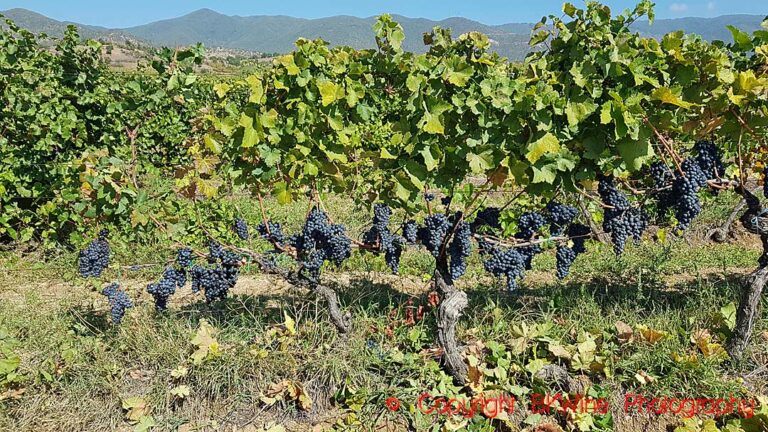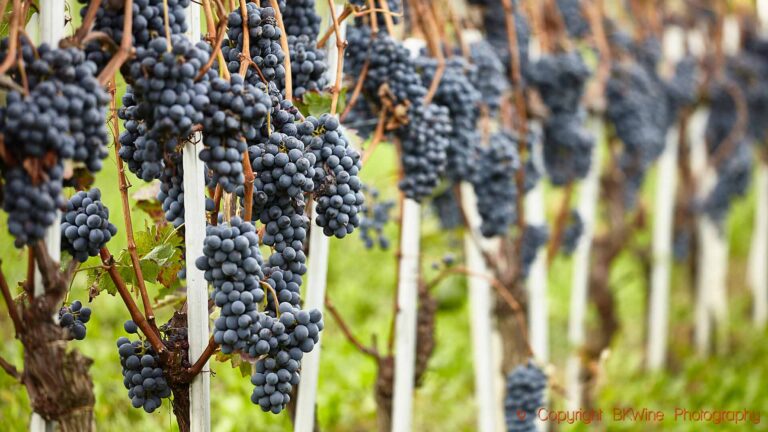Gamay is the grape in Beaujolais. It is a charming grape, easy to recognise with a fruitiness that few other grapes can beat. Gamay produces an easy-drinking, berry-like wine, sometimes a little spicy, often unpretentious, but today just as often with great ambition. Gamay appeared in Burgundy and Côte d’Oc as early as the 14th century and was grown there together with pinot noir. However, it became side-lined by pinot noir which was considered to be of much better quality. Gamay instead found a home in Beaujolais, a little further south, where it turned out to be more at-home. More on this soon.
Gamay is best known as the grape of Beaujolais, which is natural. It is indeed found in other places but to a very limited extent. Which, in a way, is surprising. Because gamay is very easy to like. It is often recognised wherever it comes from. It produces charming wines with a fruitiness that few other grapes can beat. The acidity is palpable and fresh. These are often unpretentious and easy-drinking wines. But one should not be deceived. Gamay produces highly personal and characterful wines.
–
This is a longer version of an article published on Forbes.com.
This is an article in our series of presentations of the world’s most popular and exciting grape varieties. Read other articles here:
Gamay, a trendy grape
When the Beaujolais Nouveau hysteria subsided, the Beaujolais wines suffered from a bad reputation for some years. It was partly because of overdoing the Beaujolais Nouveau phenomena and partly because of too high prices. But one important aspect is that, at the time, fruity was not as noble as structured. All that has changed now, and Beaujolais and gamay are back with a vengeance. They are even trendy. The fact that Beaujolais has some famous natural wine pioneers among its top producers has helped, of course. Gamay is the epitome of a “drinkable wine,” a style many natural wine lovers embrace. Gamay wines are the typical vins de copains, as the French say. Wines to drink with your friends.
Today, only 20% of the Beaujolais production is Beaujolais Nouveau. That is down from more than 50% when the wine peaked. But the fact is that even Beaujolais Nouveau is having a revival in many countries. And in France, the new wine is still celebrated with great enthusiasm in bars and bistros when it goes on sale on the third Thursday of November.
Gamay is mainly found in France. Of the grape’s approximately 25,000 hectares worldwide, 23,000 are in France. There used to be more. Since 2000, the surface has decreased by 10,000 ha, proof as much as anything that Beaujolais has been in trouble. Today, Beaujolais has around 14,000 hectares.
The grape appeared in Burgundy and the Côte d’Or as early as the 14th century and was cultivated together with pinot noir. However, it was sidelined by pinot noir, which was considered much better quality. Gamay instead found a home in Beaujolais, a little further south. Here, especially in the part of Beaujolais with granite soil, in other words, volcanic soil, it was also thought to thrive better.
The grape buds and ripens early, and is, therefore, in the danger zone for spring frosts. It is sensitive to grey rot and fungal diseases, and you should keep the yields down and the foliage well-groomed. It is originally a crossing between pinot noir and the very unusual white grape gouais.
Character
The gamay grapes have relatively thick skins, and the colour of a young gamay wine is medium dark with a hint of violet. The acidity is quite prominent, but the tannin content is low. Aromas of red berried such as strawberry and raspberry, often dominate, but sometimes we also find black currants. The wines tend to have a little spiciness and sometimes a floral character. The palate is refreshing and fruity. Sometimes the wines are juicy, unpretentious, and sometimes more serious with ageing potential. With age, gamay becomes more like a pinot noir.
Beaujolais
Beaujolais wines are sometimes fermented with carbonic maceration, meaning the grape bunches are not destemmed. The whole cluster are put into the tanks. This method accentuates the grape’s juicy aromas and gives the wines a special style. Beaujolais Nouveau, and many of the AOC Beaujolais and AOC Beaujolais Villages are made this way.
For the ten cru villages (Mouin-à-Vent, Morgon, Juliénas, Saint-Amour, Fleurie, Regnié, Chenas, Bouilly, Côte de Brouilly and Chiroubles), many producers prefer to destem and to make wines in a more classic style. Although these wines still retain a lovely fruit, they are more structured. Some cru wines are aged in oak barrels today, but it is rare. It changes the style. Some cru wines are full-bodied enough to handle the oak, but it would not work for a straightforward Beaujolais, and you would not want it either. In most cases, gamay gains nothing by being in oak; on the contrary.
This means that there are many different styles of Beaujolais. But the glorious fruit is always there. Gamay is also found in the Loire Valley and in Mâcon in southern Burgundy as well as in other places in the world, for example in Switzerland, but 70% of the world’s plantings are in Beaujolais.
The rest of Burgundy
The Duke of Burgundy did his best to remove gamay from the Côte d’Or, but some plantings remain. Some of it is used to make the rather unusual wine called passe-tout-grains, a blend of gamay and pinot noir. In the region of Mâcon, known above all for its white wines, they also make some reds, often from gamay.
The rest of France and the world
The Loire Valley has the second-largest surface of gamay in France, and it is the second most planted red grape in the Loire after cabernet franc. Gamay wines from Touraine are made in a light style and sometimes blended with cabernet franc and côt (malbec). We also find some delicious examples in Anjou. Also, in the Loire Valley but closer to the Atlantic Ocean is Coteaux d’Ancenis, where gamay is used for red and rosé.
Closer to the source of the Loire in the Massif Central is the Côte Roannaise. On 215 hectares, gamay is grown on granite soil, just like in Beaujolais. Not far away is the Côtes d’Auvergne with its light-coloured, pleasant gamay, often blended with a pinot noir. Savoie and the Southwest also have some gamay vineyards.
Gamay is Switzerland’s third most planted grape variety, with almost 1,400 hectares of the country’s 15,000 hectares of vineyards. The region of Geneva has become famous for its gamay wines, which are often full-bodied, spicy, and of good quality.
A grape on the rise
So, today gamay has regained its status as a quality grape, at least among many wine enthusiasts. Many wine producers today make very ambitious wines from gamay. The old “foam banana style” (artificial flavouring) is rarely seen today. The wines can sometimes approach in style and be confused with pinot noir, not least if they get a little more skin maceration and maybe a little oak aging (which must not be overdone). However, Gamay often has a slightly stronger colour and crispier fruit.
Anyone who still doesn’t take this grape seriously needs to visit a wine shop and get some of today’s top quality Gamay wines. And become a convert.
Gamay quick facts
Acreage worldwide:
- 25,000 ha
Main countries where malbec is grown:
- France 23,000 ha
- Beaujolais 14,000 ha
- Loire Valley 4,500 ha
- Switzerland 1,400 ha
- In addition, a few other countries have small plantings of gamay:
- Canada,
- Turkey,
- USA,
- Italy,
- Serbia,
- South Africa, and
- New Zealand.
Gamay’s character:
- Medium-dark colour with a hint of violet. High in acidity, low in tannin. Aromas of strawberry and raspberry, sometimes also black fruit. Often a bit spicy and floral. The wines can be very juicy, easy-drinking, and unpretentious, but sometimes more structured with ageing potential. It all depends on the winemaker and the type of vinification.

















